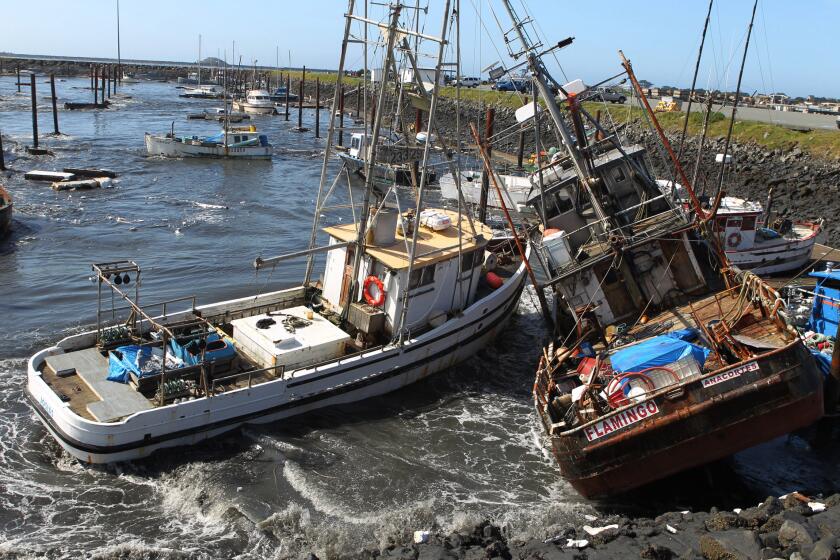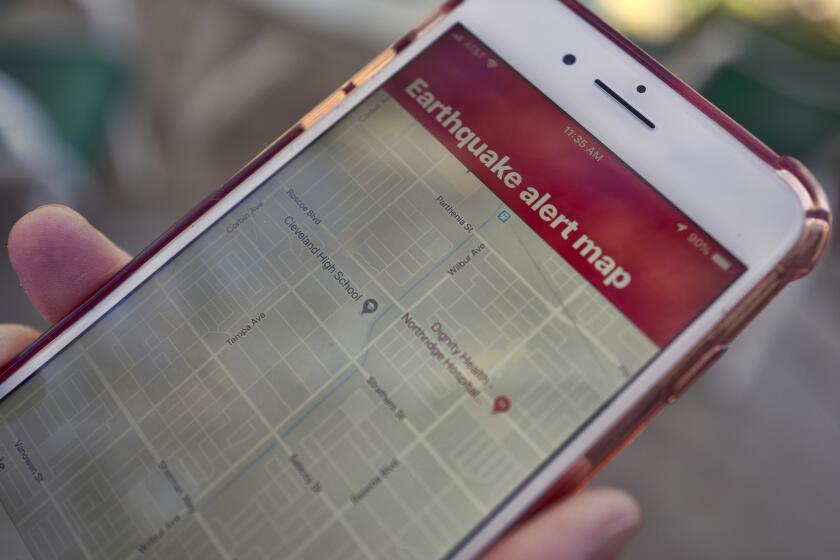Southland’s Quake Danger Forecast Is Cut
- Share via
BOULDER, Colo. — The earthquake hazard facing Southern California may be substantially less severe than scientists had calculated, according to researchers who say that they have dispelled the notion of an earthquake deficit that would trigger a stream of catastrophic temblors in the next few decades.
Based on a new analysis of the region’s previous earthquakes, researchers from the U.S. Geological Survey, USC and UCLA now have cut the predicated rate of severe earthquakes in half based on a new and more accurate model of regional seismic activity.
Nor is it as likely that Southern California will ever experience a truly mammoth earthquake of magnitude 8.0 or higher, as has been recently theorized, the researchers agreed.
“The word on Southern California is good now,” said Thomas Henyey, director of the Southern California Earthquake Center, which organized and helped formulate a 1995 assessment that formally brought the earthquake deficit to the public’s attention. Together, the two research teams have “effectively squashed the deficit to some extent, if not entirely.”
The new research, which is to be presented here today at a meeting of the Seismological Society of America, already has many scientists rejecting a concept that in recent years has injected a heightened sense of foreboding into forecasts of Southern California’s earthquake danger.
“I feel a little chagrined,” Henyey said. “I will have to retract a lot of what I said in talks, but that is how science goes.”
USGS geophysicist Ross Stein, one of the researchers whose work debunked the notion that there’s an earthquake deficit, said Tuesday that the concept had been embraced by most seismologists and geophysicists who study the region and that no one researcher should be singled out for criticism.
“We are all implicated,” Stein said. “The idea of the earthquake deficit was blessed by just about everybody.”
The “deficit” arose from perhaps the most important scientific consensus about regional seismic hazards to emerge after the 6.7 Northridge earthquake, which caused one the most expensive natural disasters in U.S. history.
Leading state, federal and university-based earthquake experts in 1995 concluded that more seismic energy had built up in the region over the centuries than had been vented through earthquakes. This deficit, they posited, would lead to an apparent surplus of titanic energy that would have to vent sooner or later through a greater number of severe quakes, each at least as powerful as the 1994 Northridge disaster.
That view has now been largely repudiated in research by Stein and his colleague Thomas C. Hanks at the U.S. Geological Survey in Menlo Park, and an independent team of three Los Angeles-based researchers: Edward H. Field and James Dolan at USC, and David D. Jackson at UCLA.
Their research papers have been submitted to the Bulletin of the Seismological Society and to the journal Nature for publication later this year.
The USGS researchers based their study on a more accurate reconstruction of the region’s seismic history. They examined 40 major earthquakes that occurred between 1903 and 1997 and concluded that there is no excess energy building up across the region that is not periodically being relieved by earthquakes.
The 1995 assessment was based on a review of earthquakes in Southern California since 1850. That review turned up what they thought was a serious discrepancy between the amount of strain building up in subterranean faults as the North American and Pacific tectonic plates squeeze past each other and the number of earthquakes that were released--resulting in what they dubbed the earthquake deficit.
But the USGS researchers found that the area was so sparsely populated for much of the 19th century that many moderate earthquakes could have easily escaped notice, throwing off the balance of the quake equation.
“When you are doing hazard and risk analysis in Southern California, you don’t want to be missing earthquakes,” said Hanks of the U.S. Geological Survey. “We determined that the rate of earthquakes was higher than believed and therefore there is no deficit to make up. The strain accumulating along the tectonic plates is in balance with the release of energy through the earthquakes we have had.”
In other words, Southern California’s tectonic account books are in balance.
The more accurate model of seismic activity in Southern California developed by Field and his colleagues buttresses that conclusion, Henyey and other researchers said. Field and Jackson would not discuss the details of their model while it is under review by Nature.
Hiroo Kanamori, director of Caltech’s seismological laboratory, said that the new research “treats the data more carefully.” Still, he warned, “the uncertainties are huge.”
Lucile M. Jones, a geophysicist at the USGS office in Pasadena, said she found the new research convincing. “I am quite willing to think we end up with no net deficit, that we really did have more earthquakes than we thought,” she said.
Even so, she cautioned, Southern California still has much cause for concern. The earthquake risk still is severe.
“What would it really change in Los Angeles?” she said. “You can take the lowest probabilities of earthquakes and still have an enormous risk--one that I suspect we have not adequately prepared for.”






